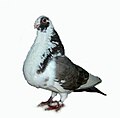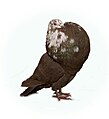Spanish pouters
Spanish pitters are a sub-group of pitters . They include hanging crop breeds, breeds with normal blowers and half-crop breeds with hardly any blowers.
Drooping breeds
The hanging crop breeds are considered to be the oldest Iberian crop breeds. They are characterized by a horizontal posture and a sack-like, pear-shaped goiter. This is not or hardly inflatable by the pigeon. All representatives of this subgroup come from Spain or Portugal and were used for the sport of thieves, catchers or decoy pigeons , in which single pigeons lure strange pigeons into their loft in free flight.
They include the "Golugueros" with a long hanging head, normal head and long beak. The "Gorgueros" have a medium-long pendulous goiter, differently pronounced nasal and lower nipples and well-developed eye rims. A third section is the Rafeno-Cropper (E / 335), also with medium length hanging goiter and recently, the Mövchentauben like beak.
Murciano-Kröpfer , Cartagenera-Kröpfer , Colillano-Kröpfer (E / 336) and Colguero-Kröpfer correspond to the first breed type with a long hanging crop. The second breed type corresponds to the Gorguero Kröpfer (E / 339) with extremely developed nasal warts, three pea-sized lower nipples, strongly developed eye rims and pearl eyes. The Jiennense Kröpfer (E / 340) is a direct descendant of the Gorguero Kröpfer and is also known as the Old Valencia Kröpfer . A younger Valenciano Kröpfer is the Valenciano Kröpfer , netherlands. Breeding direction (NL / 333). The Laudino Sevillano pouter (E / 338) emerged from Valencia pouters of Spanish breeding direction and Rafeno pouters and has extremely developed nasal warts that are similar to those of the carrier . Granadino potters (E / 343) were made in the early 20th century from old Spanish wart pigeons and thief potters. Valencia, Seville and Granada heads fly sailing with a hanging crop and V-shaped wings. Canario Kröpfer (E / 344) are dwarfed Valencia Kröpfer . Caballero crooks look like elongated carrier pigeons with a medium-long hanging crook.
Spanish crop pigeons with normal blower mechanism
Marchenero (E / 334) and Gaditano Kröpfer (E / 337) have a normal blow mechanism similar to the Central European races. The former can be traced back to the 15th century, the latter are of relatively recent origin. Regional variants of the Marchenero Kröpfer are Antequerano-Kröpfer , Hermanlino-Kröpfer , Malaguena-Kröpfer and Velano-Kröpfer . Nothing is known about the whereabouts of the Franciscan Kröpfer , the Cattagenero Kröpfer is probably only bred in South America. The Jerezano pouter , a cross between Marchenero and Valencia pouter, is preserved in the United States. Jerezano pouters of the more recent breeding direction, which arose from crossing Norwich pouters, still exist in Argentina. The Gaditano pouter emerged from their Spanish cousins.
Spanish half crooks with hardly any blowers
The half-crooks are also relatively young. Because of their very high proportion of messenger and carrier pigeons, they only show their somewhat stronger blows while driving. A sport of theft organized in clubs has been practiced with them for around 60 years. A hen is marked with a white goose feather on the tail and released together with a large number of cocks. They immediately start wooing the hen and try to drive her into her loft. The cock that manages this is a champion.
These thieves include the Alicantino or Morrillero Kröpfer (E / 341), German bull's neck , which rests the feathers of the back of the neck so much during courtship that it is reminiscent of the neck area of a bull. The front goiter itself remains a thick neck. The Moroncelo Kröpfer (E / 342) was created about 50 years ago from crosses of the Morrillero Kröpfers with blue, white-winged city pigeons from the small town of Morón de la Frontera . The Laudino goiter was a widespread thief pigeon in Spain with a degenerated hanging goiter until around 1950. From this, the Spanish modern thieves' crookers emerged through repeated crossings of Belgian carrier pigeons , wild rock pigeons and flying tipplers . Outwardly, however, its relationship with crookers and half crookers is no longer apparent, as it looks very similar to the wild type of rock pigeon.
gallery
Individual evidence
- ↑ a b Joachim Schütte: Handbook of the pigeon races. The pigeon breeds in the world . 1994, ISBN 978-3-9801504-4-6 ( Spanish crop pigeons ).
- ↑ Josef Fischer: The Spanish Kröpfer . In: The book of the Kröpfer . 2nd Edition. Publishing house Reutlingen Oertel + Spörer, Reutlingen 1980, ISBN 3-921017-86-6 , p. 83-91 .
- ^ Kurt Vogel: Die Taube , Deutscher Landwirtschaftsverlag, Berlin 1984.
- ↑ Entente Européenne d'Aviculture et de Cuniculture : EE list of pedigree pigeons (ELRT) ( Memento of the original from April 15, 2013 in the Internet Archive ) Info: The archive link has been inserted automatically and has not yet been checked. Please check the original and archive link according to the instructions and then remove this notice. , As of June 11, 2012 (PDF, approx. 150 kB)
Web links
- Special association of breeders "Spanish hanging pigeons" on spanische-kropftaubenrassen.de, with breed information, sample descriptions and galleries.





